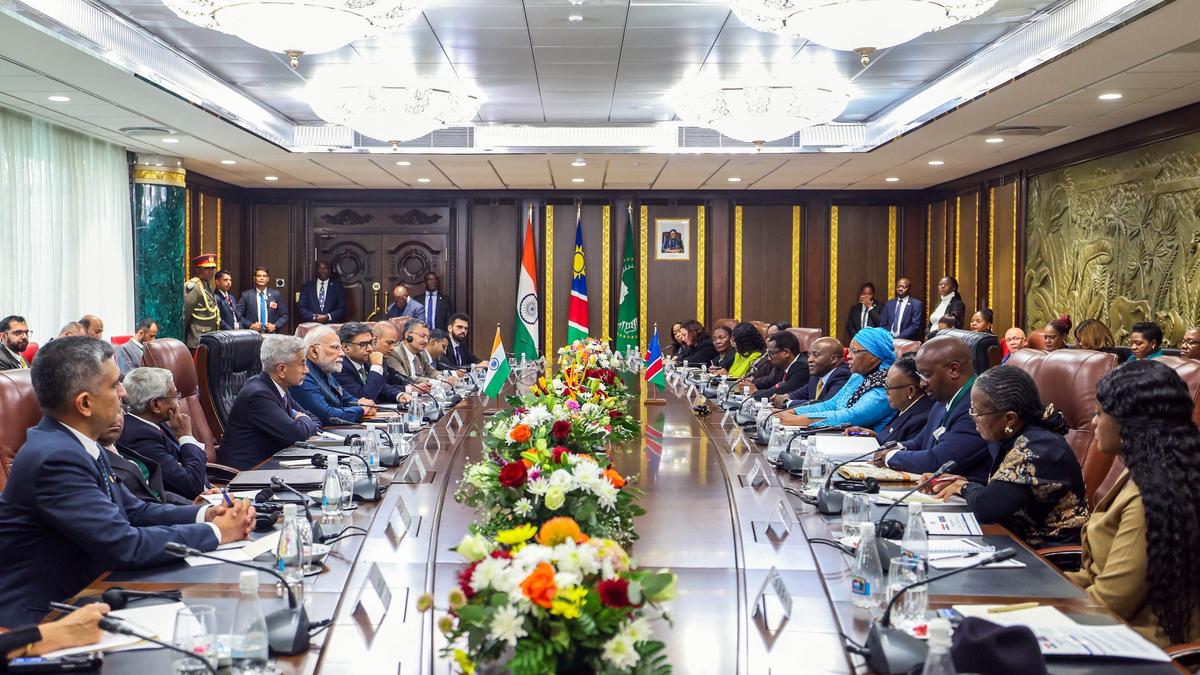In his address to Namibia’s National Assembly in July this year, Prime Minister Narendra Modi quoted a Namibian poet, invoked the symbolism of the Welwitschia mirabilis plant (the national plant) and the Springbok, and sprinkled his remarks with phrases in Oshiwambo, earning laughter and applause.
The gesture suggested a deliberate effort to engage with culturally meaningful terms, reflecting a more grounded approach to partnership-building. It is a sharp contrast to western engagement, which continues to be shaped by conditional aid, travel bans, and episodic withdrawals such as the recent USAID cutback, and is increasingly tied to migration deterrence, with assistance hinging on controlling outward migrant flows.
The steps being pursued
India is pursuing a quieter, adaptive approach, favouring alignment over instruction and forming issue-based coalitions. Underlying this appears to be a deliberate three-step logic: evoking shared historical solidarities, engaging in present-day pragmatic cooperation, and investing in long-term, future-oriented ties. This offers insights into what more thoughtful, durable partnerships with African states might look like.
The first step anchors diplomacy in a shared anti-colonial heritage, drawing on historical memory not as nostalgia, but as a legitimate force of solidarity. There are gentle but meaningful reminders: that New Delhi hosted the South West Africa People’s Organization’s first-ever diplomatic office during Namibia’s liberation struggle; that Lieutenant General Diwan Prem Chand, an Indian officer, commanded the United Nations peacekeeping forces during Namibia’s delicate transition to independence. These references are not incidental. They create a sense of long-haul engagement, contrasting with the episodic presence of many other powers.
Second is to highlight the depth and the breadth of current cooperation. New Delhi’s bilateral trade with Windhoek is $800 million, modest but growing, and supported by a $12 billion development partnership across Africa. More significant are India’s targeted investments in capacity-building, including the India-Namibia Centre of Excellence in IT at the Namibia University of Science and Technology, and the ‘India Wing’ at the University of Namibia’s Ongwediva campus, funded by a $12 million grant. These efforts leverage India’s strengths in IT and respond to Namibia’s youthful population and digital readiness.
Third, and closely linked, India is laying out a road map for the future by pivoting toward knowledge-based cooperation. Namibia’s recent adoption of India’s Unified Payments Interface (UPI), the first country in Africa to implement this, signals a quiet revolution in tech diplomacy. If this succeeds, it will offer a model for transferring not just digital tools but also regulatory frameworks, institutional design, and user-centric tech architectures that India has stress-tested at scale.
Advantage Namibia
Crucial to this approach is the choice of partner. Namibia’s political stability, rich mineral resources and growing technological base offer a strong foundation for India’s engagement, grounded in shared histories and aligned futures. President Netumbo Nandi-Ndaitwah’s call to reform global economic and financial systems for fairness and resilience echoes India’s own vision for inclusive, equitable governance. More than a bilateral partner, Namibia is a key collaborator in the Global South’s broader effort to reshape international rules in line with their collective aspirations, agency, and demand for a more just world order.
While India and Namibia share a compelling vision for partnership, consistent follow-through remains a challenge. India’s developmental ambitions are often criticised for uneven implementation, and its engagement with Africa has seen long lapses, evident in the recent visit to Namibia by an Indian head of government, the first in nearly three decades.
Though symbolically important, the visit’s outcomes were modest: two memoranda of understanding on entrepreneurship and health, and Namibia’s accession to the Global Biofuels Alliance and the Coalition for Disaster Resilient Infrastructure. These are valuable steps but fall short of the scale the moment, and the bilateral potential, clearly calls for.
Notably absent was any major agreement on Namibia’s critical mineral reserves. As a leading uranium producer, Namibia is a natural partner for countries such as India seeking resilient low-carbon supply chains. The visit offered a clear opportunity to outline a strategic framework, including resource access, local workforce development, or investment in value addition. Though the issue was acknowledged, discussions ultimately failed to produce concrete outcomes.
Regardless, India’s approach, while not without its gaps, stands out not just for what it offers but also how it engages. India’s quiet recalibration emphasises trust built through inclusive dialogue, acknowledging histories, and letting African priorities shape the agenda.
Move beyond symbolism
The upcoming India-Africa Forum Summit, anticipated in the near term, could serve as a vital platform to formalise and solidify these diplomatic efforts through institutional cooperation. It presents an opportunity for India to build on recent momentum and demonstrate that its commitment to partnership and mutual respect is backed by enduring political resolve.
Delivering on this vision, however, will require more than symbolism. It will entail confronting structural and operational shortcomings at home and ensuring that India’s strategic ambitions are matched by sustained investment and institutional coherence. Ultimately, India’s credibility as a Global South partner will rest not only on what it commits to but also on how consistently and collaboratively it follows through.
Veda Vaidyanathan is Fellow, Foreign Policy and Security Studies at the Centre for Social and Economic Progress. The views expressed are personal
Published – August 18, 2025 12:08 am IST
